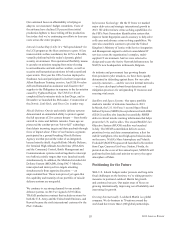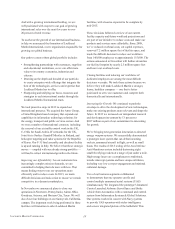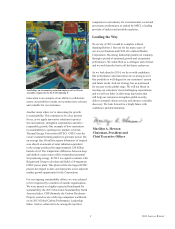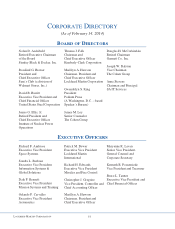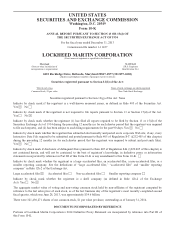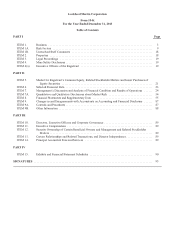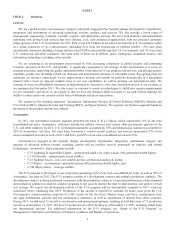Lockheed Martin 2013 Annual Report Download - page 14
Download and view the complete annual report
Please find page 14 of the 2013 Lockheed Martin annual report below. You can navigate through the pages in the report by either clicking on the pages listed below, or by using the keyword search tool below to find specific information within the annual report.Space Systems
In 2013, our Space Systems business segment generated net sales of $8.0 billion, which represented 18% of our total
consolidated net sales. Space Systems’ customers include various government agencies of the U.S. and commercial
customers. In 2013, U.S. Government customers accounted for 98%, international customers accounted for 1%, and U.S.
commercial and other customers accounted for 1% of Space Systems’ net sales. Net sales from Space Systems’ satellite
products and services represented 12% of our total consolidated net sales in each of 2013, 2012, and 2011.
Space Systems is engaged in the research and development, design, engineering, and production of satellites, strategic
and defensive missile systems, and space transportation systems. Space Systems is also responsible for various classified
systems and services in support of vital national security systems. Space Systems’ major programs include:
• The Trident II D5 Fleet Ballistic Missile, a program with the U.S. Navy for the only current submarine-launched
intercontinental ballistic missile in production in the U.S.
• The Space Based Infrared System (SBIRS), which provides the U.S. Air Force with enhanced worldwide missile
launch detection and tracking capabilities.
• The Advanced Extremely High Frequency (AEHF) system, the next generation of highly secure communications
satellites for the U.S. Air Force.
• The Orion Multi-Purpose Crew Vehicle (Orion), a spacecraft for the National Aeronautics and Space
Administration (NASA) utilizing new technology for human exploration missions beyond low earth orbit.
• Global Positioning System (GPS) III, a program to modernize the GPS satellite system for the U.S. Air Force.
• The Geostationary Operational Environmental Satellite R-Series (GOES-R), which is the National Oceanic and
Atmospheric Association’s next generation of meteorological satellites.
• The Mobile User Objective System (MUOS), a next-generation narrow band satellite communication system for
the U.S. Navy.
Operating profit for our Space Systems business segment includes our share of earnings for our investment in United
Launch Alliance, which provides expendable launch services to the U.S. Government.
Financial and Other Business Segment Information
For additional information regarding our business segments, including comparative segment net sales, operating profit,
and related financial information for 2013, 2012, and 2011, see “Business Segment Results of Operations” in Management’s
Discussion and Analysis of Financial Condition and Results of Operations and “Note 4 – Information on Business Segments”
of our consolidated financial statements.
Competition
Our broad portfolio of products and services competes both domestically and internationally against the products and
services of other large aerospace, defense, and information technology companies, as well as numerous smaller competitors,
particularly in certain of our services businesses. We often form teams with other companies that are competitors in other
efforts to provide customers with the best mix of capabilities to address specific requirements. In some areas of our business,
customer requirements are changing to encourage expanded competition, such as information technology contracts where
there may be a wide range of small to large contractors bidding on procurements. Principal factors of competition include the
value of our products and services to the customer; technical and management capability; the ability to develop and
implement complex, integrated system architectures; financing and total cost of ownership; our demonstrated ability to
execute and perform against contract requirements; and our ability to provide timely solutions.
The competition for international sales is subject to additional U.S. Government stipulations (e.g., export restrictions,
market access, technology transfer, industrial cooperation, and contracting practices). We may compete against domestic and
foreign companies (or teams) for contract awards by international governments. International competitions also may be
subject to different laws or contracting practices of international governments that may affect how we structure our bid for
the procurement. In many international procurements, the purchasing government’s relationship with the U.S. and its
industrial cooperation programs are also important factors in determining the outcome of a competition. It is common for
international customers to require contractors to comply with their industrial cooperation regulations, sometimes referred to
as offset requirements, and we have undertaken foreign offset agreements as part of securing some international business. For
more information concerning offset agreements, see “Contractual Commitments and Off-Balance Sheet Arrangements” in
Management’s Discussion and Analysis of Financial Condition and Results of Operations.
6



